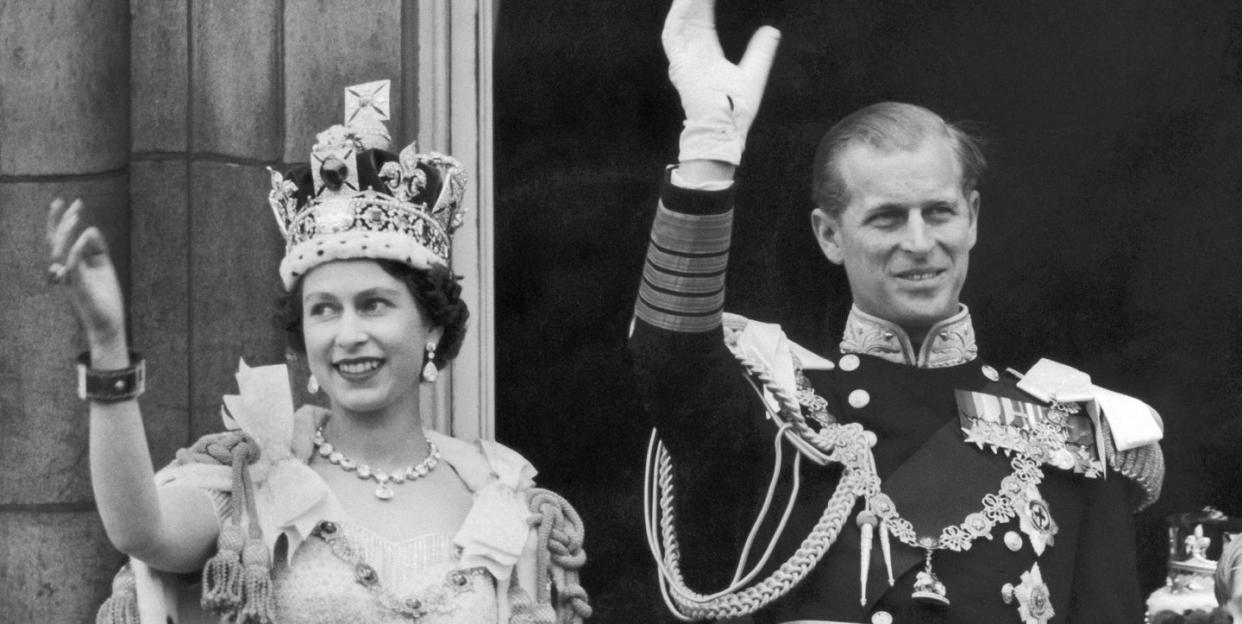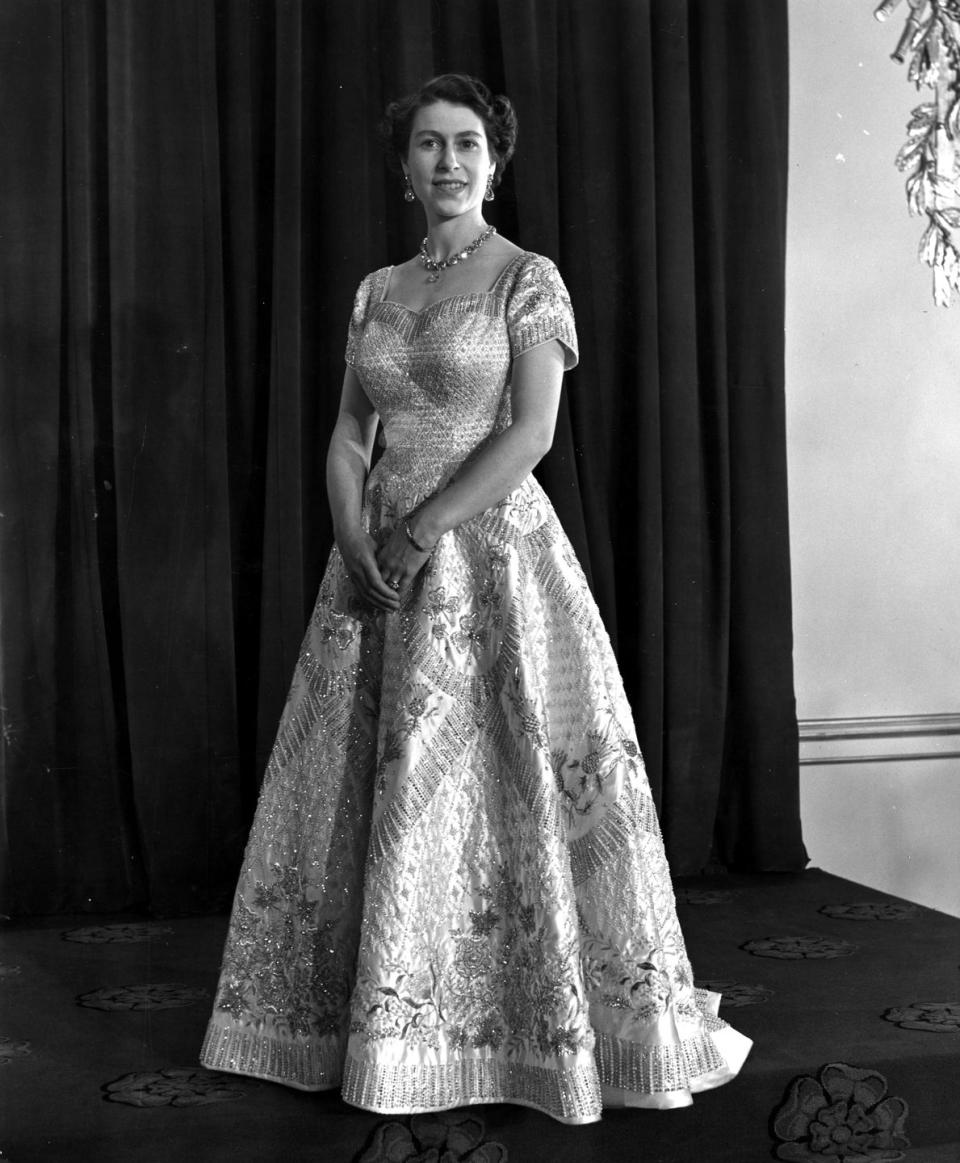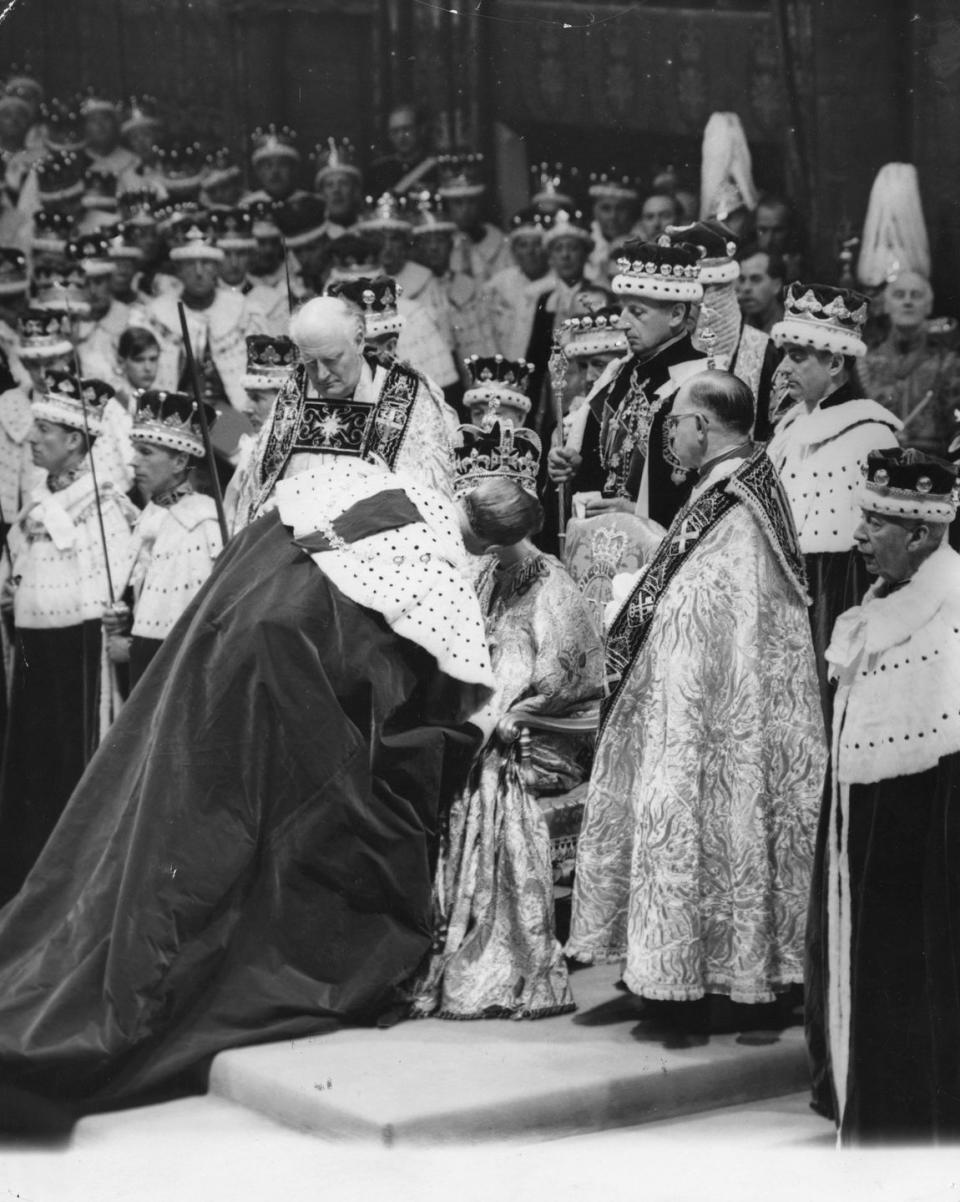What was it like behind the scenes at Queen Elizabeth II's coronation?

Prince Charles has a vivid childhood memory from the run-up to coronation day. The four-year-old ventured into his mother’s study; she was sitting at her desk with a giant crown on top of her head. This imposing ermine-trimmed and jewel-encrusted treasure dated back to Charles II. The Queen delicately explained to her son that she was trying to get used to the weight before she was crowned. Other monarchs – Victoria and Edward VII – reneged on wearing it, but Elizabeth was not a woman for half measures and practice makes perfect.
St Edward's crown is one of the heaviest and certainly the most iconic of all the coronation regalia, but 2 June 1953 would also be remembered as a family day, with Charles another of his mother’s vital accessories. The public were enthralled, the press overjoyed; here was the people’s Queen allowing her subjects to penetrate "at last, even vicariously, into the solemn mysteriousness of the Abbey scene", where the little Prince was in sight, sitting next to his beloved grandmother on the balcony, hair plastered down with "the most appalling gunge".

It had all the ingredients of a great national event; everyone was involved, my own mother included. Her father, Peter Blenkin, was a superintendent in the Metropolitan Police; on coronation day he was tasked with lining the route and stationed at Hyde Park Corner, but things hadn’t gone according to plan. "They ran out of horses, so Father had to stand and his ceremonial sword dangled on the ground. He should have been mounted." No matter, at least Mum had a seat and, aged 11, a drawing slate to keep her occupied. "I was envious of my cousin because she was in the Mall and saw the Queen, but I knew I was very lucky to be part of it and I was struck by all the military, especially the Gurkhas." She pauses. "King George had made such an amazing impression, so there was unconditional love for Elizabeth. I was brought up to be in awe of her, she was a fairy Queen."
And it was a fairy-tale day. The Union Jack Mum waved is one of her favourite keepsakes, so too a teeny-tiny lead replica of Elizabeth’s golden horse-drawn coach. But the highlight was still to come. "We rushed back to Granny’s house in Kent. She’d bought a nine-inch television. It was set up in the billiards room and we watched what we’d missed on the little black-and-white screen." My mother’s love affair with the royal family was sealed. Their story was part of her story. Their family entwined with her family. Royal, Anglican and accessible, that Sunday in church she prayed for "Mummy, Daddy and Queen Elizabeth".
The scene was replicated up and down the country. In total, nearly eight million watched the coronation at home, another ten million crowded into neighbours’ houses. The average television set had seven people hunched around it. Trestle tables were erected, paste sandwiches eaten and bunting hung. Despite the dismal weather, this was a national holiday and an unforgettable celebration. "The archways and the banners will be taken down. But no one can take down the memories in the hearts of millions who have seen Coronation London."

Mum pauses. "No, I don’t think I was especially aware of Prince Philip. I mean it was all about the Queen. Philip, well, he wasn’t terribly interesting to a girl of 11." And judging by the coverage, most of the public agreed with her. Walking the ‘side streets’ of London, "all more or less slums" on coronation day, a student noticed that in nearly every window there were pictures of "the Queen and/or [her] children". Philip was far harder to find. This anecdote mirrored press coverage that focused on a maternal image of the Queen with Prince Charles, which historian Edward Owens argues was part of a deliberate royal strategy to keep hearts and minds on the line of succession.
Edward, the Duke of Windsor, was still lurking in the background and the runaway success of his memoir, A King’s Story, in 1951 didn’t help. Elizabeth could not prohibit her disgraced uncle from appearing at his brother’s and mother’s respective funerals in 1952 and ’53 but he was forbidden from attending the coronation. How dare he try and reclaim the limelight – 2 June 1953 was all about commitment, duty, and God-given divinity.
The future was Charles, not Edward. The latter hit back in a letter to his wife: "what a smug, stinking lot my relations are". It’s difficult being on the losing side. As one Dimbleby (Jonathan) noted of another’s (Richard’s) broadcast: "Inside the Abbey, a television camera framed the young prince at the moment when the Archbishop of Canterbury placed the crown on his mother’s head. It was a fleeting glance, but it seemed to say, 'You, my child, will be next!'"
The House of Windsor was on display for all the world to see. The Queen was the main protagonist in her Hartnell gown. Still impeccably preserved today, up close the dress, with its tiny waist and dimensions, is a striking reminder of how petite our late monarch was; unimpeachable, beautiful and unquestionably feminine. The coronation script couldn’t keep up: "Receive the ring of Kingly dignity . . . Reign with him who is the King of Kings." Here was God’s servant, our Queen, Charles’ mother and Philip’s wife, in that order.

Back in the 1950s, the tendency is to assume that vanity stopped with women. The Queen, wrapped in embroidered satin with "sugar-pink cheeks" and "tightly curled hair", was "absolutely ravishing" and her six "lily-like ladies" in their prickly gowns (one must suffer for beauty) "looked sublime". Fifty Wrens in the coronation procession were told by the navy to: "Go easy on the lipstick", as girls must "apply make-up with moderation". And yet, behind the scenes, there was a different story at play. Anne Glenconner, then Coke, daughter of the 5th Earl of Leicester and a maid of honour, recalls that the Duke of Norfolk "had the foresight to work out that his bald patch would need to be powdered a few times, due to the aerial shots the television cameras would take".
Meanwhile, the 5th Marquess of Cholmondeley "seemed very proud of his looks – he always sat bolt upright with his head slightly to one side". It was men like these – older, vain, posturing – who were in charge of the Queen. The Marquess oversaw the sovereign’s costume changes, the Duke of Norfolk showed him what to do. Philip, his naval uniform hidden beneath his gown and coronet, looked on as other men laid claim to his wife, the monarch. Later, Anne Glenconner described the Duke of Edinburgh’s behaviour when entering the Abbey as "very fussy" and "adding to tension". Can you blame him? Even the press couldn’t resist a comparison between "the puffy pomp of the peers and the almost film-star handsomeness of the Duke of Edinburgh".
Vivat! Vivat! After the Archbishop of Canterbury, Philip was the first peer to kneel before his wife and pay homage:
I, Philip Duke of Edinburgh, do become your liege man of life and limb, and of earthly worship, and faith and truth will I bear unto you, to live and die, against all manner of folks. So help me God

Fanfares of trumpets, a blaze of violins and a kiss on the cheek for his wife and her wobbly crown. It was a three-hour service, with more to come once the state coach wended its way back to Buckingham Palace. The ‘rain poured, the crowds still roared’ and photographs still had to be taken. Lots and lots of them, images now so engrained in our national psyche that it’s hard to imagine the crowned Queen in any pose that isn’t faintly kitsch with a golden orb and fake ‘blow up’ Abbey in the background.
An empathetic woman, she had predicted that, by the time the photograph stage was reached, everyone would be exhausted. They were and her husband didn’t hide it. With a ‘ragging attitude’, Philip abandoned pleasantries in front of photographer Cecil Beaton. ‘His lips pursed in a smile that put the fear of God into me. I believe he doesn’t like or approve of me.’ Making a ‘great deal of fuss’, the ‘frightfully bossy’ Duke infuriated the photographer; there was a spat and indignant Beaton briefly downed tools. Apparently, the Queen was horrified. But such tension was predictable. Philip, ‘disappointed that his friend Baron’ hadn’t got the coronation job, made life difficult for Beaton. Baron was Philip’s special Thursday Club conspirator and had taken the royal wedding pictures, but, six years on, the Queen Mother’s photographer trumped her son-in-law’s.
Brandreth has explored this slight at length in his biography, concluding that ‘Baron was Philip’s man and Philip was someone Queen Elizabeth [the Queen Mother] did not entirely trust’. He repeats Sir John Wheeler-Bennett’s remark of her that there was a ‘small drop of arsenic in the centre of that marshmallow’. Perhaps. Either way, Beaton loved his bosomy patron; he thanked her for clinching him the gig and concluded at the end of the day that the only time he’d felt ‘airborne’ was when photographing ‘the Queen Mother and her grandchildren’. Needless to say, the photographs only tell half the tale.

Anecdotally, it's clear Philip overplayed his hand on 2 June 1953 and his discomfort did not go unnoticed. But while the Queen Mother could take care of the grandchildren, only the Queen could placate the conundrum that was her husband. In the evening, she broadcast to the nation. First she thanked her subjects:
I have sincerely pledged myself to your service, as so many of you are pledged to mine. Throughout all my life and with all my heart I shall strive to be worthy of your trust.
But only one person was singled out as travelling with her on that journey: ‘In this resolve, I have my husband to support me. He shares all my ideals and all my affection for you.’ In June 1953, the nation was almost exclusively focused on Elizabeth, but it was thanks to Philip that she was more than just a Queen, she was an exalted image of the ideal 1950s’ woman: ‘a radiant young wife and mother’ and a monarch.
For a patriarchal society struggling to find itself post-war, the package was both reassuring and fresh, and, better than anyone else, Elizabeth understood its value. She confidently rebutted comparisons with her Tudor forbear, Elizabeth I, explaining that, unlike the Virgin Queen, she was not a despot ‘blessed with neither husband nor children’.
The success of Britain’s twentieth-century monarchy was premised on marriage; beyond the crowns and oaths and crowds, Elizabeth needed Philip. It helped that she loved him.
Excerpted from Elizabeth & Philip: A Story of Young Love, Marriage, and Monarchy by Tessa Dunlop. Published by Pegasus Books. © Tessa Dunlop. Reprinted with permission.
You Might Also Like


